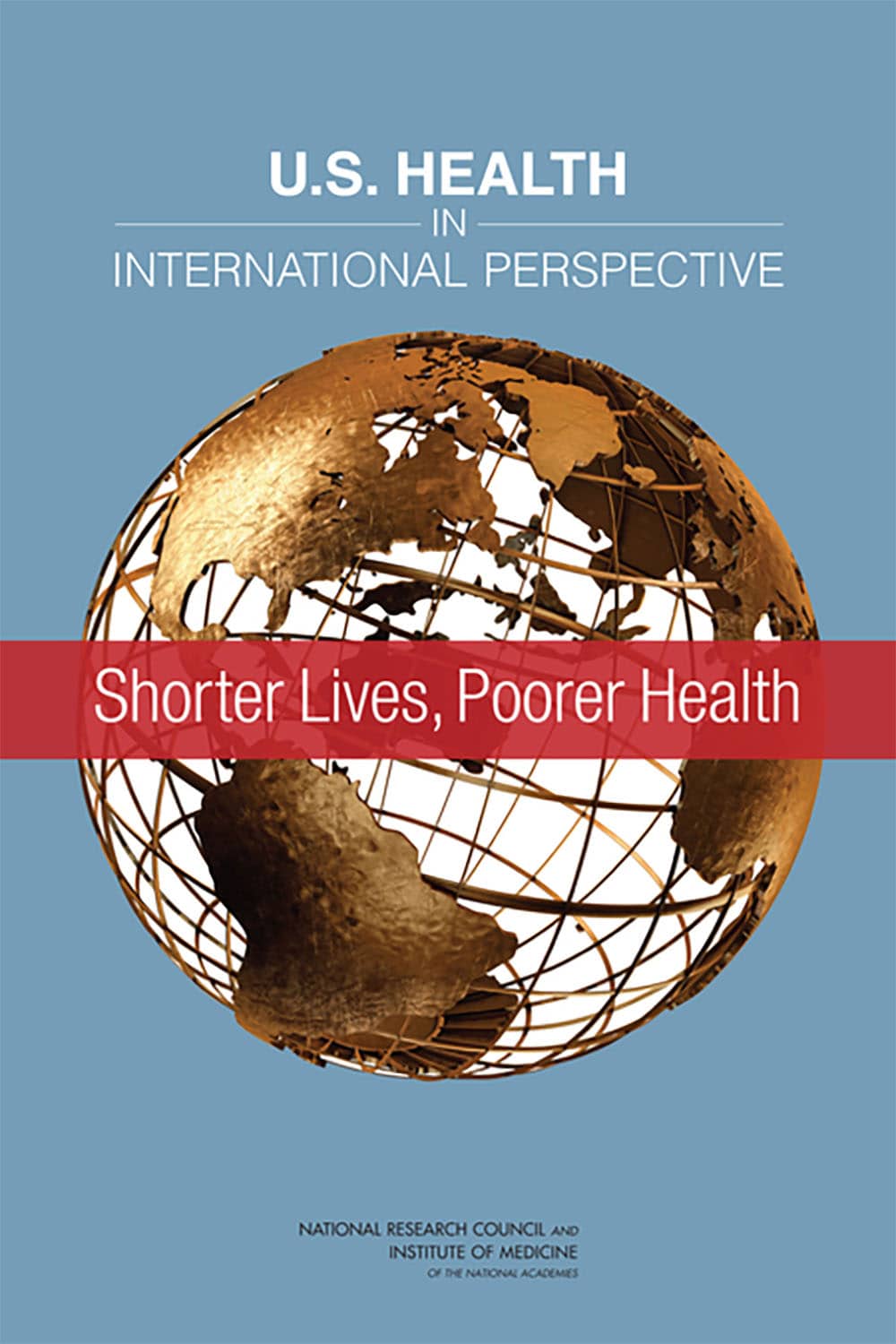Are Conservative Policies Shortening American Lives?
In 2013, a research team comprised of some of the nation’s top epidemiologists and demographers compared the health of Americans with the health of people in other high-income nations. They summarized their findings in the report’s title: “U.S. Health in International Perspective: Shorter Lives, Poorer Health.”
Compared to 16 other nations, the U.S. ranked dead last in life expectancy for males and second-to-last for females. Beyond that, the nation ranked at or near the bottom in nine broad areas, including injuries and homicides, drug-related deaths, heart disease, and diabetes. Lung disease was both more common and more deadly in the U.S. than in most of the comparison countries, while older adults were more likely to have arthritis than people in the United Kingdom, Europe, and Japan. The U.S. surpassed all other nations in its rate of infant death. It had the highest rate of new AIDS cases. American young people were more likely than their international peers to die in traffic accidents.
A “catalog of horrors,” as a writer at the Council on Foreign Relations summed up the report. Newspaper coverage included words like “stunned” and “surprised.” “It is now shockingly clear that poor health is a much broader and deeper problem than past studies have suggested,” read an editorial in The New York Times.
Since the report’s publication, the Organization for Economic Cooperation and Development, the World Health Organization, and others have continued to document the ongoing slide in U.S. health compared to other countries. “As bad as things were then, they’ve only gotten worse,” said Steven Woolf, a physician and public health researcher at Virginia Commonwealth University who chaired the panel of experts behind the Shorter Lives study.
Indeed, as of 2019, the U.S. ranked 36th in the world in terms of life expectancy at birth, behind Slovenia and Costa Rica, not to mention Canada, Japan, and all the rich countries in Europe. And new research published in the Journal of the American Medical Association in December found that, although White people living in the nation’s highest-income counties have better health outcomes than the average U.S. citizen, even they fare worse on infant mortality, maternal mortality, and deaths after heart attacks than the average citizens of Norway, Denmark, and other developed countries.
In retrospect, the 420-page report was a harbinger of things to come, and many experts now say it foreshadowed the U.S. experience with Covid-19. “The abysmal performance of the U.S. — leading the world in death counts and unable to mount the kind of national response that so many peer nations achieved — adds a fresh twist to the U.S. health disadvantage,” Woolf said.
His research team was convened by the National Academy of Medicine and the National Research Council to suss out why the U.S. suffers the “health disadvantage” that it documented, but it was unable to do so. Common explanations — obesity, lack of access to health care, health disparities between White and Black people — were all at play, but the exact cause, or combination of causes, was not clear.
The troubling portrait of America’s health did not spur action to paint a better one. Two presidential administrations have ignored it, as has Congress, mirroring a lack of interest shown by the wider public. Still, some social scientists have not stopped asking: What’s causing the U.S. health disadvantage? Recent work points to a surprising culprit: conservative policies.
This idea stems from a new line of research focusing on individual states, rather than the country as a whole, which has found that states with more liberal policies have longer life expectancy rates than those with more conservative policies. If all states adopted policies similar to those of Hawaii, for example — including on labor, tobacco, and the environment — U.S. life expectancy would increase to such an extent that it would be on par with other high-income countries, according to Jennifer Karas Montez, a sociologist at Syracuse University and lead author of the new research.
Of course, the findings do not definitively prove that a given set of state policies causes people to live longer; rather, they suggest a statistical association between a state’s policies and the health of its residents. And not everyone is convinced that transposing one state’s policies onto other states’ populations will lead to better health outcomes. Still, public health researchers say the question is worth pursuing — though the next step will be a tricky one: getting the public and their political representatives on board.
In 2002, Ravi K. Sawhney moved to Washington, D.C. to look for any job that would allow him to work in health policy. An orthodontist by training, Sawhney describes himself as a person who likes to fix things. He chose orthodontics because he liked the way braces fixed his own teeth. Then he studied molecular and cellular biology to better understand how teeth move and develop ways to improve orthodontics. “But I started to realize that we’re not suffering from a lack of good orthodontists or molecular biologists,” he said. “It’s that we have weird policies that aren’t working to make health better.”
After two jobs on Capitol Hill, he landed in Building One, the Office of the Director of the National Institutes of Health campus in Bethesda, Maryland. The NIH, the largest biomedical research organization in the world, includes the National Cancer Institute, the National Institute on Aging, the National Institute of Mental Health, and 24 other institutes or centers. Its 2020 budget was almost $42 billion. The Office of the Director, which oversees the entire enterprise, is comprised of dozens of administrative units, including the Office of Science Policy. That’s where Sawhney was working when, in 2006, he learned of some new research findings that became his obsession.
By then, the U.S. had been losing ground on life expectancy, relative to other countries, for decades. The disparity had been attributed to America’s high poverty rate and racial inequality. But that reasoning became more complicated when a research team stumbled upon the fact that White Americans are significantly less healthy than the British. “It was a bit of a big shock,” Michael Marmot, a professor of epidemiology and public health at University College London who led the research, said in an NPR interview at the time. “I just didn’t imagine we’d find it consistently across the board, with worse health in the United States compared with England.”
Marmot — actually Sir Marmot, having been knighted in 2000 for his extensive research into health inequalities throughout the world — and three colleagues were trying to find out why poor people are less healthy than rich people. Because they were exploring how income and education influenced health independently of other factors, they looked only at non-Hispanic White people aged 55 to 64 in the U.S. and England. What they learned: In both countries, people with less education and income had worse health than their more advantaged countrymen. Writing in the Journal of the American Medical Association, they reported that White Americans had worse health than their British peers at all rungs of the socioeconomic ladder.
In Sawhney’s view, that should have prompted some introspection at the NIH. But in the ensuing years, Sawhney grew frustrated that America’s health disadvantage did not get high-level attention, even though additional research showed that older Americans were not just less healthy than their British counterparts, but less healthy than other Europeans as well. “When you find out that every other rich country in the world — without better technology, without more spending on biomedical research — is healthier, it undermines your case that what you are doing is right,” he said.
So he spearheaded the effort to get a bigger set of eyes focused on the issue. The National Academy of Medicine (then known as the Institute of Medicine) is a nonprofit organization that, as part of the National Academies of Sciences, Engineering, and Medicine, is authorized by Congress to advise the federal government on medical and public health issues. Its members are elected because of their important contributions to their fields, and it undertakes big-picture research studies on a contract basis along with the National Academies’ research arm, the National Research Council. In this case, the NIH funded research to review health data for all ages of life, not just older people.
Woolf was recruited to chair the panel; other members were primarily academic experts in epidemiology, demography, and economics. Many had spent their careers looking at international health comparisons, but none had ever seen the data for all health conditions in one place before. “There were many of us, including myself, who expected we would outperform some countries in some disease areas and underperform in others,” Woolf said. “But what was so stunning to us was that, with very few exceptions, we were consistently underperforming.”
Laudan Aron, now a senior fellow at the Urban Institute, a Washington D.C.-based think tank, was the Shorter Lives study director, responsible for editing and writing the report along with Woolf. Panel members were struck, she said, by how consistently the U.S. health disadvantage washed across Americans from all subsets of the population — rich and poor, highly educated and not, old and young. Members of some racial and ethnic minority groups have much worse health than their White compatriots, but even well-to-do, highly educated White people with health insurance suffered a health disadvantage because they lived in the U.S.
There were some bright spots. Americans who manage to reach the age of 75 live longer than their peers in other countries. The U.S. also has higher rates of cancer survival, better blood pressure and cholesterol control, lower stroke mortality, and lower smoking rates. But, compared to peers in other rich nations, many Americans do not live to see old age; since 1980, the U.S. has consistently had the first or second lowest probability of surviving to age 50.
As the report neared publication, the research team wanted to make sure that the public and, even more importantly, policymakers in a position to take action were aware of the Shorter Lives findings. “We just took it upon ourselves to start contacting reporters that we knew and draw attention to this,” Woolf said. Their efforts were reciprocated with a flurry of colorful headlines. To take just one example, an op-ed in The Washington Post announced: “The United States needs to see the doctor.”

What happened next? “Disappointingly little has been done since that report,” said John Haaga, who retired as director of National Institute on Aging’s Division of Behavioral and Social Research last year. “The level of interest in how we are doing relative to other countries is very low.” The NIH has continued to fund studies that compare health and health systems across countries, noted William T. Riley, director of the agency’s Office of Behavioral and Social Sciences Research (OBSSR). But some experts say it hasn’t funded projects that would identify what other healthier countries are doing differently — a key recommendation of the Shorter Lives authors.
Robert M. Kaplan was director of OBSSR, the main funder for Shorter Lives, when it was produced, and he remains enthusiastic about it all these years later. “I can go on and on about this report — it’s one of my favorite topics,” said Kaplan, now the director of research at Stanford Medical School’s Clinical Excellence Research Center. In his view, the report should have changed the way the NIH invests in health research. But the report was not popular among many NIH leaders, he said, because the findings refute the idea that more funding for basic biomedical research — the thing NIH is famous for — translates into better health.
At its inception, the NIH was focused not on biomedical research, but on public health — the science of protecting and improving the health of a population. It traces its roots to 1887, when a one-room laboratory was created to help test ship passengers arriving in the U.S. for cholera and yellow fever. In the ensuing decades, it went through different names and an expanding mission, which included regulating the production of vaccines, investigating diseases caused by polluted water, and discovering the source of an anthrax outbreak. In 1930, Congress renamed the agency the National Institute of Health (it wouldn’t become plural until 1948) and authorized it to research basic biological and medical problems.
Since then, the NIH has grown to become the largest public funder of biomedical research in the world, responsible for breakthroughs that are undeniably important. One of its major neuroscience initiatives recently helped figure out how to create speech from brain signals. The Cancer Moonshot, launched in 2016, is working on cancer prevention and early-stage detection. The All of Us Research Program is collecting health records and DNA samples from 1 million volunteers to advance precision medicine. Those initiatives are an easy sell for congressional funding, Haaga said. “It’s all very exciting — I love that stuff,” he added. “It’s just that it hasn’t been connected to health improvements for American people as promised.”
Haaga means “connected” by evidence that Americans, as a whole, are living longer, healthier lives than people in other wealthy countries that are not investing as heavily in biomedical research. This rhetorical connection between NIH research and the nation’s health is a key part of its official messaging. “Americans today are living longer and healthier,” the agency’s website reads, crediting NIH-funded research for the fact that “life expectancy in the United States has jumped from 47 years in 1900 to 78 years as reported in 2009.”
That’s a stretch, Kaplan said, considering that the NIH did not start its research grant programs until 1946. In the first half of the 20th century, mortality rates declined dramatically because of improved sanitation practices, better nutrition, and the discovery, by a British scientist, of antibiotics. Life expectancy at birth saw its greatest increase — from 47.3 years to 68.2 years — between 1900 and 1950. “That is when the real acceleration was,” Kaplan said.
Sawhney, who has a doctorate in biology, believes NIH leaders may find the Shorter Lives conclusions easy to dismiss because the agency favors bench scientists over social scientists. “Anything that comes out of epidemiologic research — like the health disadvantage — is suspect,” he said.
By documenting the health disadvantage of living in the U.S., Shorter Lives raises the obvious question: Why? Explanations are both easy and hard to come by. “If you ask really top, smart medical or public health scientists, they will immediately tell you they know the answer,” Sawhney said. “And they will all give you different answers.”

In demonstrating America’s health disadvantages, the Shorter Lives study raised an obvious question that has been difficult to answer succinctly: Why?
He rattles off the usual suspects — stress, food portion sizes, lack of exercise, and others. The National Academies research panel reviewed evidence for many possible culprits, ranging from lack of access to medical care to seatbelt use to poverty. Nearly half of the Shorter Lives report is devoted to exploring that evidence, but the researchers concluded that no single factor fully explains the U.S. health disadvantage.
Shorter Lives did refute some easy assumptions. “When you talk to the general public, they say, ‘We want people to live longer so let’s invest more in medicine,’” Kaplan said. “Health care certainly is a contributor to life expectancy, but the report did a very good job of clarifying that achieving better health requires more than just providing health care.”
Researchers also looked at the effect of individual behaviors. For example, eating a high-fat diet in early life can lead to obesity, which can cause diabetes and heart disease. But why is there so much childhood obesity in America? Shorter Lives points to government policies that encourage production of cheap, fattening foods; school district decisions about high-calorie cafeteria menus and vending machine contracts; business decisions about where to locate grocery stores and fast-food outlets; the marketing of electronic devices to children; and neighborhoods that are too unsafe for children to play outside. “Choices may not always be made ‘freely’: they are made in a societal and environmental context,” the report said.
As it took in the whole picture, the research committee was of two minds on how to discuss the issue of why, Woolf said. One argument was to address each problem independently: Why does the U.S. have so many unwanted pregnancies? Why so many car accidents? “But there were a number of us who felt like there’s something too coincidental going on here,” Woolf said. “Something about the way we go about doing things here in America is probably responsible for the structural factors — what you might call the ‘causes of the causes.’”
Woolf and his colleagues became convinced that the answer to why lay not only with biology and medicine, but with governance and political decision-making. Political scientists who compare the decisions that countries make about social welfare and other programs were brought in to help the committee think through the issues. That led to an extra Shorter Lives chapter, not originally planned, that explored how policies and societal values may be influencing American health.
 |
For all of Undark’s coverage of the global Covid-19 pandemic, please visit our extensive coronavirus archive. |
Among other things, it discussed how five “iconic American beliefs” may encourage policies and individual behaviors that hurt our health. On the surface, it may seem absurd to claim that an illness like heart disease might stem from individual freedom, free enterprise, self-reliance, the role of religion, and federalism. But the authors offer possible explanations.
For example, the constitutional right to bear arms reflects the American value of personal freedom. Firearms are more available in the U.S. than in peer countries, and homicide rates are higher. A 2011 study of 23 high-income countries found that the U.S. rate of firearm homicide was 19.5 times higher than the average for the other countries. Similarly, Americans prize self-reliance, prompting many to believe individuals should solve their personal problems without “handouts,” so raising taxes for state-financed health programs is often unpopular. Six years after the Affordable Care Act went into effect, 12 states have not expanded Medicaid, despite the federal funding that would cover at least 90 percent of the cost.
The Policies and Social Values chapter was “kind of fringy or too political or philosophical,” Kaplan said, and it didn’t get much attention. But its basic tenet — American values may be hurting our health — has been on his mind lately as he conducts survey research about Covid-19 protocols.
“Boy, does this come up a lot when we talk about mask requirements and whether the government has the right to track you,” he said. “I actually do think we’re different than other countries.”
Even if America’s policies and core values explain why U.S. health is so poor, that explanation does not directly help with a related question: What should be done?
Shorter Lives made six recommendations, none of which directly tackled any possible root causes for poor health. Four are related to the need for more research or better research methods; one calls for a media campaign to inform the public about the U.S. health disadvantage; and one advocates for pursuing national health goals that had been previously established. Still, Woolf thinks Shorter Lives makes it obvious that America’s social problems contribute to its health problems and should be addressed immediately. “If your house is on fire, you don’t say, ‘Hold up with all those hoses, let’s first demonstrate that there’s evidence that the water is going to extinguish this fire,’” he said.
Racial bias, for example, is associated with greater disease prevalence, unequal access to quality medical care, and other health disparities between Black and White people. W.E.B. Du Bois documented the disparities and tied them to societal inequities back in 1899; more than a century later, a Black American will live about three fewer years on average than a White person with the same income. “That’s the product of systemic racism — there’s no biological reason for it,” Woolf said. “That really needs to be addressed if we are going to solve this.”
Health disparities are the differences between subgroups, such as Black and White people, in a population. The U.S. health disadvantage, on the other hand, extends to all Americans in comparison to people in other countries. Haaga, trained as a demographer, does not think addressing health disparities is the best way to tackle the health disadvantage of living in the U.S. “Yes, we’re violent; yes, we’re too individualistic; yes, we’re racist,” he said. “But we were those things before 1975, and somehow that was not incompatible with being among the healthiest people in the world.”
He wanted Shorter Lives to explain why “the rot set in” in the mid-1970s, sending the U.S. in a downward health and mortality spiral in comparison to other countries — and to provide a to-do list for improvement. “We should work on all of these systemic issues and cultural issues but, by golly, there must be something we can do,” he said. “If we’re falling behind Portugal and they are spending way less [on health] than we are, what are they doing? What can we do?”
Research published in September may offer some clues. Instead of asking, “Why is life expectancy in Portugal three years longer than in the U.S.?” Montez and her colleagues decided to ask, “Why is life expectancy in Hawaii seven years longer than in West Virginia?”
The researchers based their work on a dataset created by political scientist Jacob Grumbach to document policy polarization across the states. Grumbach used an established system to score 135 policies in 16 domains — including abortion, civil rights and liberties, education, gun control, immigration, and taxes — on a conservative-to-liberal continuum for every year between 1970 and 2014. Viewed together over time, the data show how individual states became more conservative or liberal during the 45-year study period.
Montez and her colleagues — including Woolf, chair of the panel behind Shorter Lives — merged the state policy data with life expectancy data for each of the 45 years to see whether there was any association. Their finding: States that implemented more conservative policies were more likely to experience a reduction in life expectancy.
The study shows statistical associations, rather than causal relationships, between policies and life expectancy rates, and Montez says the work should be considered “suggestive evidence” that needs to be replicated. That said, the findings are consistent with other research that has demonstrated the effect that an individual policy can have on health and longevity. “Studies on minimum wage, for example, show that a minimum wage change can have an effect on infant mortality rates within a year,” she said.
The researchers also looked into other factors that might be driving the decline in life expectancy. For example, they explored whether state-specific economic conditions — as measured by unemployment rates each year — altered their findings; they did not.
Life expectancy rates between states have increasingly diverged since the early 1980s, shortly after the federal government began transferring policymaking authority to the states, giving them more influence over programs like Medicaid and welfare. More recently, state-level power has grown via preemption laws, in which states curtail local authority over smoke-free ordinances, nutrition labeling in restaurants, and other issues. In 2000, only two states prohibited local jurisdictions from raising the minimum wage; today, 25 states do so.
As states have gravitated to more liberal or conservative sets of policies, their life expectancy rates have taken different trajectories. For example, Connecticut and Oklahoma had the same life expectancy in 1959, but by 2017, Connecticut had gained 9.6 years while the more conservative Oklahoma had gained just 4.7 years. Policies on tobacco, labor, immigration, civil rights, and the environment appear to be particularly influential for life expectancy. “We know states that we can look to: What is Connecticut doing? What did New York state do?” Montez said. “We can also look to the states that are declining and say, ‘What did they do wrong?’”
Thus, the U.S. offers 50 individual case studies that show how policies are linked to health, Montez said.
So should states with conservative policies become liberal to improve their citizens’ health? It’s not that straightforward, Haaga says, because state-level policies generally reflect the values and individual behaviors of the state’s voters. Kentucky, for example, has the second-highest smoking rate in the nation and the 35th lowest tobacco tax. “One of the unhealthy behaviors is you vote for people who don’t pass laws or make regulations that support healthier behaviors,” he said. “Whenever you’re looking at specific policy impacts, you have to remember that a lot of these things go together, especially when politicians are competing for the votes of people who want to believe that they can smoke however they want.”
Some advocates say the problems documented in Shorter Lives demand a national response from the very top of government. Shortly after the report was published, Ronald Bayer, a professor at Columbia University’s Mailman School of Public Health, and three colleagues made that call to action in Science. “Mobilization of an unprecedented kind is now necessary in the United States,” they wrote. “It requires a campaign to remove the public veil of ignorance about the evidence.” They called for then-President Obama to create a National Commission on the Health of Americans to hold public hearings and determine “vigorous” next steps.
Obama did not pursue that suggestion, and other elected officials also took a pass. “I would have thought that congressional representatives and senators would have picked it up and said, ‘We need to do something — this is really bad,’” said medical sociologist David V. McQueen. “‘Why do we spend so much money and get so little impact?’”
Will a government agency lead an effort to eradicate America’s health disadvantage? The NIH’s Riley has ideas about what needs to happen next. “The first step is to quit saying that we have the ‘best health care in the world’ and acknowledge that we have serious health care and public health weaknesses that need to be addressed,” he said in a written response to Undark’s questions. From there, Riley suggests that the U.S. needs a strong public health system integrated with social policies that support good health.
In fact, America’s public health agency, the Centers for Disease Control and Prevention, boasts that no other organization in the world has its skills and capacity. McQueen held several top leadership positions there before he retired. Just as the NIH has a primary focus on biomedical research, he said, the CDC is focused on its own top priority: controlling infectious diseases. “The kind of work that came out of Shorter Lives was not a leading interest of senior people, except for a few,” he said.

When Shorter Lives was published, baby boys born in the U.S. could be expected to live 3.7 fewer years than if they had been born in Switzerland. For American girls, life expectancy was 5.2 fewer years than their counterparts in Japan.
Visual: Digital Vision via Getty
And maybe America’s health problem is just too hard, as suggested in Shorter Lives itself: “[T]he largest obstacle to addressing the U.S. health disadvantage is not a lack of evidence or uncertainty about effective interventions but limited political support among both the public and policymakers to enact the policies and commit the necessary resources to implement them.”
McQueen sees a “kind of general anti-intellectualism” in the nation’s unwillingness to address economic and social factors underlying poor health. “We like to see solutions that are proximal and simple,” he said. A medicine that lets a patient live with diabetes is a simple solution; changing food policy so that fewer people develop diabetes is not.
None of this lets the NIH off the hook, in Haaga’s view. By 2040, the U.S. life expectancy is expected to drop to 64th in the world, trailing Algeria, the Dominican Republic, and Sri Lanka, according to projections done by researchers at the Institute for Health Metrics and Evaluation at the University of Washington. “I semi-seriously proposed that we have a separate fund at NIH and out of every $100 dollars, $1 would be put into the ‘Hey, how come nobody’s healthy?’ fund,” Haaga said. “And that would be a big increase on the amount of money we spend to research that seemingly basic question.”
At the time Shorter Lives was published, baby boys born in the U.S. on average could be expected to live 3.7 fewer years than if they had been born in Switzerland. For baby girls born in the U.S., life expectancy was 5.2 fewer years than those born in Japan. When Woolf presented those and other Shorter Lives findings to congressional committees, he found that they did not always resonate with lawmakers.
He says that Sens. Bernie Sanders and Elizabeth Warren were enthusiastic about the revelations, but neither was particularly influential at the time, and nobody else seemed to care much. Even rich White Americans are dying at higher rates than their international peers, he pointed out, but it did not make an impression. “There’s a certain amount of denial among the policymakers,” he said. “What we were explaining ran so counter to the narrative that many politicians have of American exceptionalism and too many believe that, if you’re a corporate executive or a billionaire, you’re fine.”
His assessment would not surprise Stephen Bezruchka, a professor at the University of Washington. A physician by training, Bezruchka has devoted the past three decades to educating the American public about the country’s poor health status relative to other countries. He developed the concept of the “Health Olympics” to help people visualize how the U.S. lags behind Malta, Chile, Barbados, and many other countries in life expectancy.
Last June, Bezruchka was the keynote speaker at a conference at which he presented the facts about America’s health. The event was held virtually because of the pandemic, and reviewing the online chat afterwards he recalls being struck by a post that read: “But this is still the greatest country in the world.”
That perspective leads to cognitive dissonance when Americans hear the bad news about our health, Bezruchka said. James Banks and James Smith, two of Marmot’s collaborators on the 2006 JAMA study, pointed this out when they published an international comparison of health status for older adults in 2012. The U.S. ranked 12th out of 13 rich countries in life expectancy at age 50 but a greater percentage of Americans reported their health to be “excellent” than the residents of all but two of those countries. The authors’ summed up the paradox: “The United States ranks poorly on all indicators, with the exception of self-reported subjective health status.”
Haaga has seen a “profound lack of interest in a lot of American audiences” to consider international health comparisons. Wouldn’t Americans be intrigued to learn that U.S. health status compared favorably to that of Canada in the 1970s, but has slipped considerably since then? “I made this kind of a feature in my public speaking,” he said. But, he added, “I found that audiences just glaze over.”
McQueen sees the same tendencies in the Covid-19 era. Other countries have emphasized quarantine, contact tracing, and other practices to limit the spread of disease. In the U.S., however, prevention efforts have been controversial, and the priority has been on developing vaccines and medical treatments.
“Even with Covid, the U.S. sees itself as a particular model and what happens elsewhere is kind of irrelevant,” said McQueen. “We are, after all, the greatest country in the world, the richest and the greatest with the greatest health care system — which, of course, is not true, but people believe that.”
This article was written with the support of a journalism fellowship from The Gerontological Society of America, The Journalists Network on Generations, and The Gannett Foundation.













Comments are automatically closed one year after article publication. Archived comments are below.
America is all about money; always has been. Officials and business and now, health providers, care least of all. Wellness is not profitable for them. Unnecessary visits and tests for everyone, not to mention expensive pharmaceuticals.
As for Americans themselves, there is not getting around the system. Insurance does not pay for anything; we all pay for it, and health care takes high advantage of Medicare, Medicaid, and private insurers. Want to know why “health” care goes up? Ask the health providers . This “care” does not make anyone healthier, just feeds the greedy health care system, especially now that senior citizens are a major part of the population.
Hi Lola, I’m late to the party however having just read your well researched article I am struck by what I believe to be the primary cause for the declining health in the US and so, wanted to share. I am not a conspiracy mongrel, but I could make a strong argument for an obtuse collusion between the agricultural industrial complex with the food industrial complex with the medical industrial complex with the pharmaceutical industrial complex with the insurance industrial complex all tied together through lobbyists who encouraged policy at every level of the government. This collusion creates inferior foods stocks which are transformed but he food industry into empty nutrient value, high calorie, cell damaging substances which create excessive oxidative stress via free radical production, excessive inflammatory response and tissue, gland and organ breakdown. This in turn is treated with new to nature substances with further alter health DNA express….(You get the drift.) And when the majority of the executive level positions in the FDA, CDC and NIH are held by post corporate executives, then we run into policy problems as evidenced and sited in your article, for which I am grateful. If we use take a Systems Network perspective it is clear that the issues facing our Nation in its declining health are not only systemic, but go a bit further up the proverbial “food chain”, to what is the core value of our country. And it is profit at all cost.
The US has an Asshole Based Economy (ABE) introduced in the early to mid 1980s by President Reagan. Who could have predicted abusing employees to profit the rich would adversely affect health? Oh yeah, every leader of every first world country except the US.
Such a fantastic article that shows the complexities of health. It isn’t a cut and dry answer, and that partly is why no one pays much attention to it. It’s a multifaceted issue and one I’d love to talk at lengths about with people because it really is dire.
Americans have no general food culture and eat a lot of junk food; they retain more than 20 chemicals in food production banned in other developed countries; their food is soaked in Roundup; they are the most heavily vaccinated country; they are the most medicated people, consuming most of the world’s pharmaceuticals including 80% of painkillers which poison bodies and the environment; they have higher rates of poverty and working poor than other developed nations; they have high rates of semi-literacy; they allow drug advertising on television; their political system legalises corporate corruption which makes it hard to correct such errors…….
the real question is how could any of them be healthy?
We should also look at ethnic groups that have particularly long lifespans. I’ve blogged (Power to the Patient) about lower income Asian-American communities that have life expectancies longer than that of many wealthier white communities. I identified factors such as Asian diets being healthier than the typical American diet (small groceries featuring healthy food prevent food deserts from springing up), Asian-Americans being likely to practice stress management techniques such as tai chi, getting more sleep than non-Asians, and showing greater respect for the elderly. These factors are most prevalent in first and second generation immigrants and likely fade as families become more acculturated to life in the US. Successful attempts have been made to improve the diets of non-Asian low income people, like the New Orleans Food Coop, and these need to be replicated.
America has the highest vaccination rate in the world. The quantities of vaccination administered have risen enormously since the 1950s, which is around the same time the acceleration in life expectancy began to taper off. In 1950 there were 3 childhood vaccines typically given when a child entered school. By 2016 the schedule had increased to 74 doses by age 17. I’m not necessarily suggesting a direct causal link, but the impact of excessive vaccination rates is certainly a factor which should be considered when examining America’s declining health outcomes.
it is certainly one factor which should be studied but with the power of pharma in government, will not be.
There were fewer babies vaccinated because of Covid and SIDS rates fell. That will be ignored.
Although this piece is hardly unexpected and tells some hard truths, I expect better than this old mistake: “life expectancy in the United States has jumped from 47 years in 1900 to 78 years as reported in 2009″. That figure gives the impression that the average person dying in 1900 was 47 when it was much higher. The figure is massively skewed because of huge rates of infant mortality. If a child survived its first few years, it was likely to live the standard Old Testament lifespan of ‘three-score years and ten”.
This dodgy data crunching is common. Your point is solid.
Improved living conditions say incidence decline and mortality plummet, long before vaccines.
In 1970, Dr Edward H. Kass, of Harvard, gave a speech to the annual meeting of the Infectious Diseases Society of America, of which he was then President.
He warned about drawing false conclusions about why mortality rates had declined.
He said:
“….we had accepted some half truths and had stopped searching for the whole truths. The principal half truths were that medical research had stamped out the great killers of the past —tuberculosis, diphtheria, pneumonia, puerperal sepsis, etc. —and that medical research and our superior system of medical care were major factors extending life expectancy, thus providing the American people with the highest level of health available in the world. That these are half truths is known but is perhaps not as well known as it should be.”
Also look up –
In 1977, Boston University epidemiologists John and Sonja McKinlay published a seminal work on the role vaccines (and other medical interventions) played in the massive decline in mortality seen in the twentieth century.
The McKinlay’s study was titled, “The Questionable Contribution of Medical Measures to the Decline of Mortality in the United States in the Twentieth Century.” Their data showed:
“that the introduction of specific medical measures and/or the expansion of medical services are generally not responsible for most of the modern decline in mortality.”
It’s very common everywhere to list that standard statistic.
And improving child mortality is still a medical and social success, so this technicality doesn’t really matter much outside data nerds, in the context of the overall articles points.
Regardless, there are better measures, like “life expectancy after reaching 10 years old”
Which has improved by 10 years since 1950.
But it’s improved by almost 20yrs in Japan.
Good article with some shocking information. Nevertheless, I am surprised to find chemicals — especially modern ones like PFAS’, Pesticides, flame retardants, endocrine disrupters, PEGs, etc, — apparently missing from the picture. Putting them into the equation might answer some questions.
Interesting comment, Lee. Are Americans exposed to higher levels of those chemicals than in other, healthier, nations? I expect that most Americans would be exposed to similar levels of chemicals, due to federal regulation of pesticides, flame retardants, etc., so state-to-state comparisons have limited use. It would be good to know instead if there is a correlation between disease rates and chemical use/exposure in different countries. Such international research doesn’t get much funding because the NIH, CDC, and HHS leadership have never acknowledged that Americans are sicker.
I’d be very surprised if the USA’s regulations of toxic materials were as rigorous as in most other developed nations, given the vicious antipathy which that country’s politicians, CEOs and other people of power display towards any kind of brake on corporate practices. A brief online search revealed no obvious means to compare. Perhaps you can point to research showing how various countries differ in their regulation of materials hazardous to health.
The US allows more than 20 chemicals, banned in other developed nations, to be used in food production.
Toxic exposure is a hard thing to quantify properly between countries and regions. But it can’t have a huge effect in the end, given toxic exposure, poor sanitation, intense air and water pollution, is common to over a billion Chinese people.
It’s still a country where lethal industrial chemicals are placed in baby’s milk and toothpaste and toys for years before anyone catches it. Where air pollution is so bad, my friends constantly cough up black phelgm. Where food and water safety is horrendous, esp in common street foods, where sometimes oil from gutter sewage is reprocessed as cooking oil.
Yet, their life expectancy is only 2 years less than Americans.
Research also shows Canadians get similar levels of toxin exposure as Americans, yet they live many years longer.
Can blame 2 years on it, but it’s laughable to consider any larger difference. Except for QALY. But that’s a much more complicated calculation.